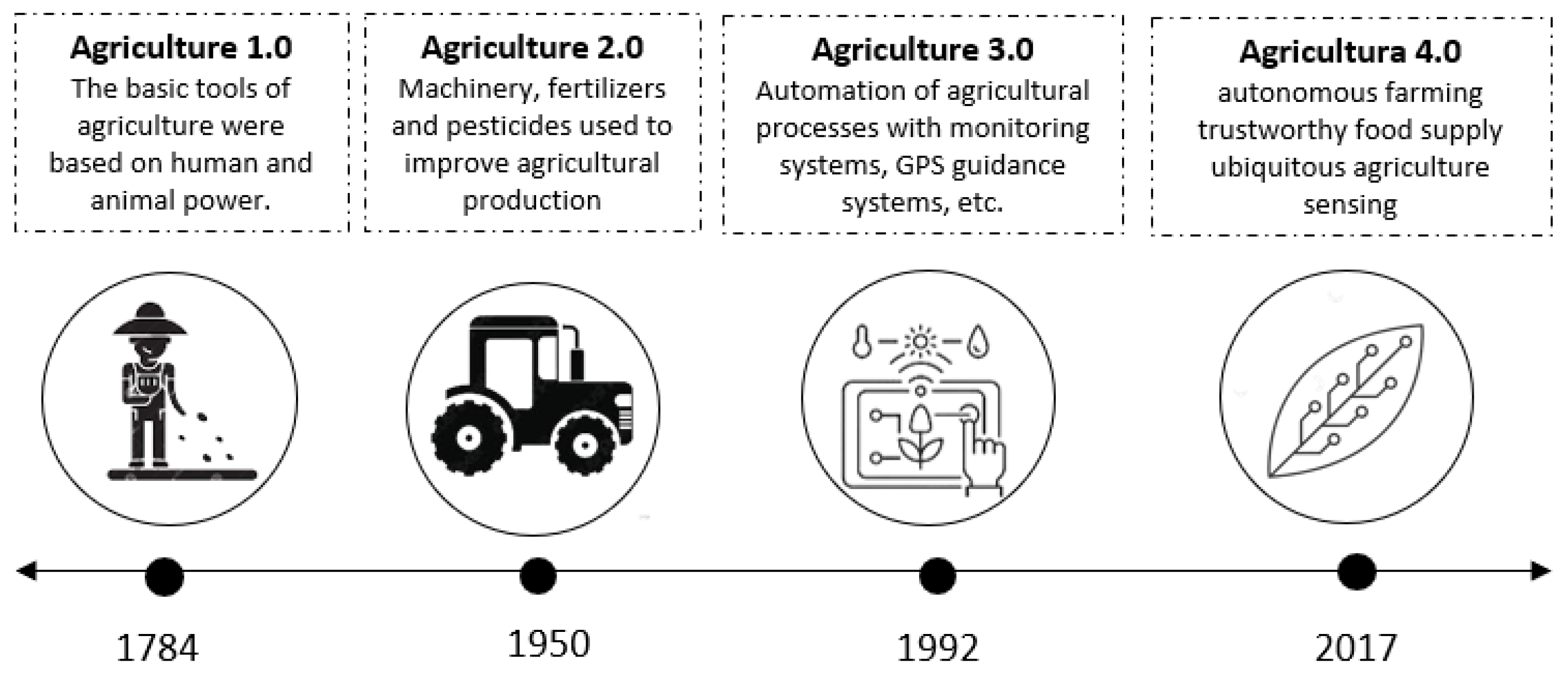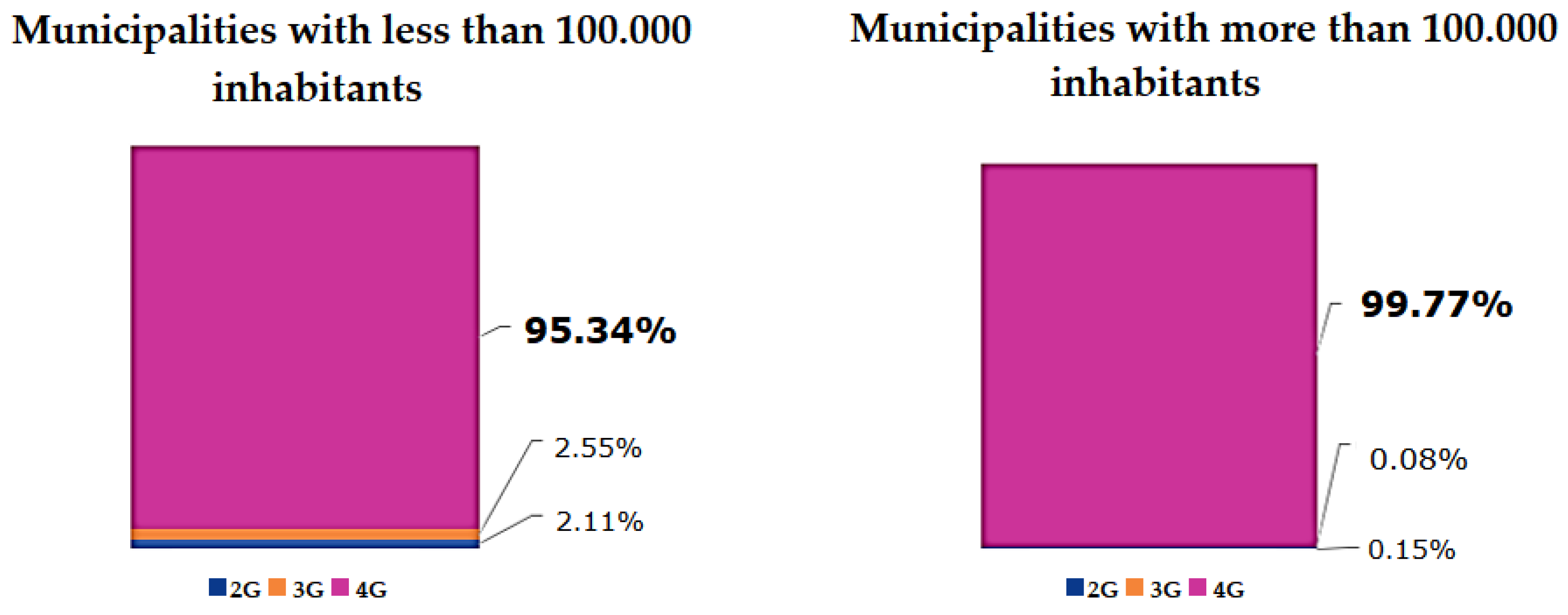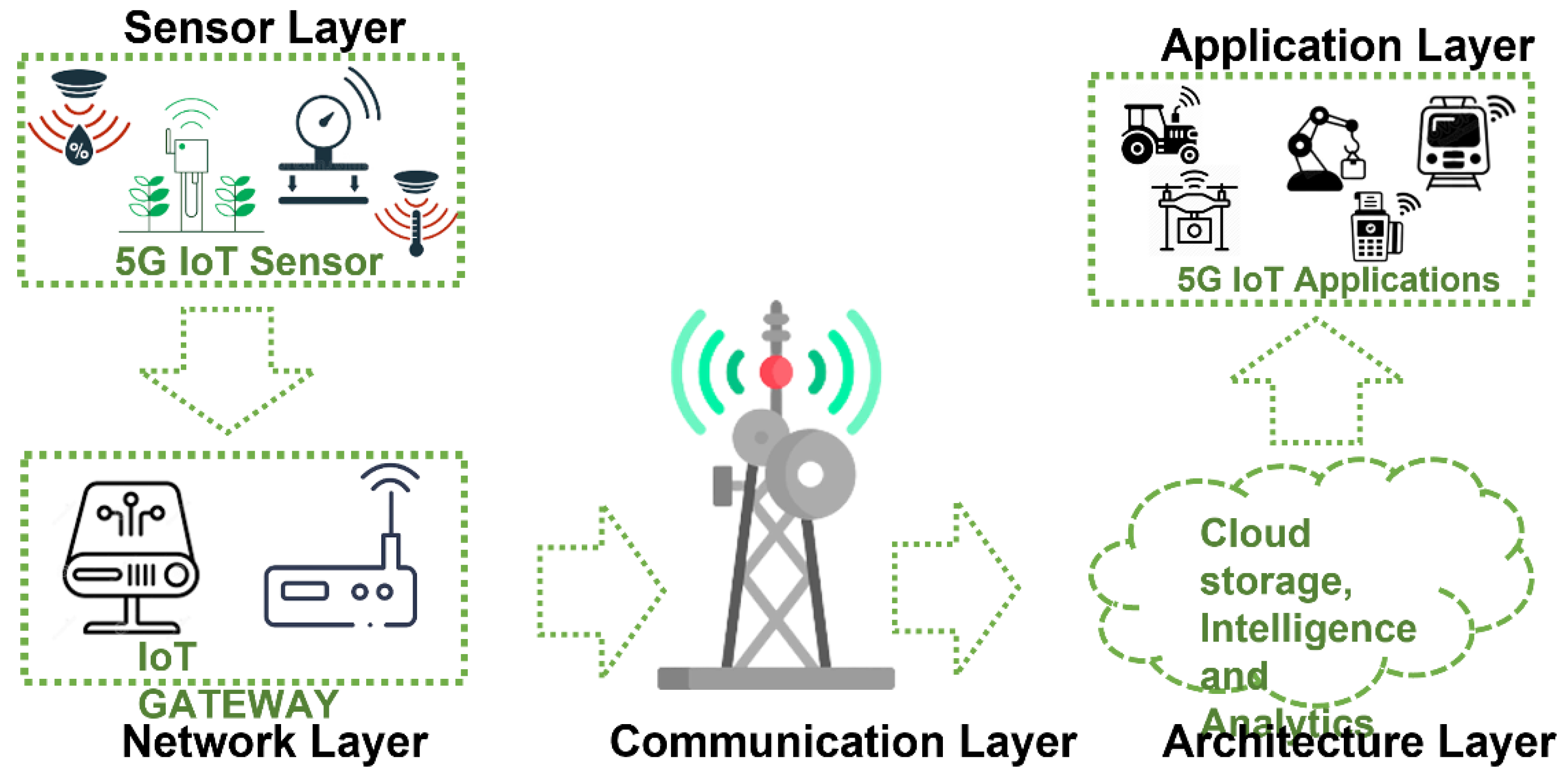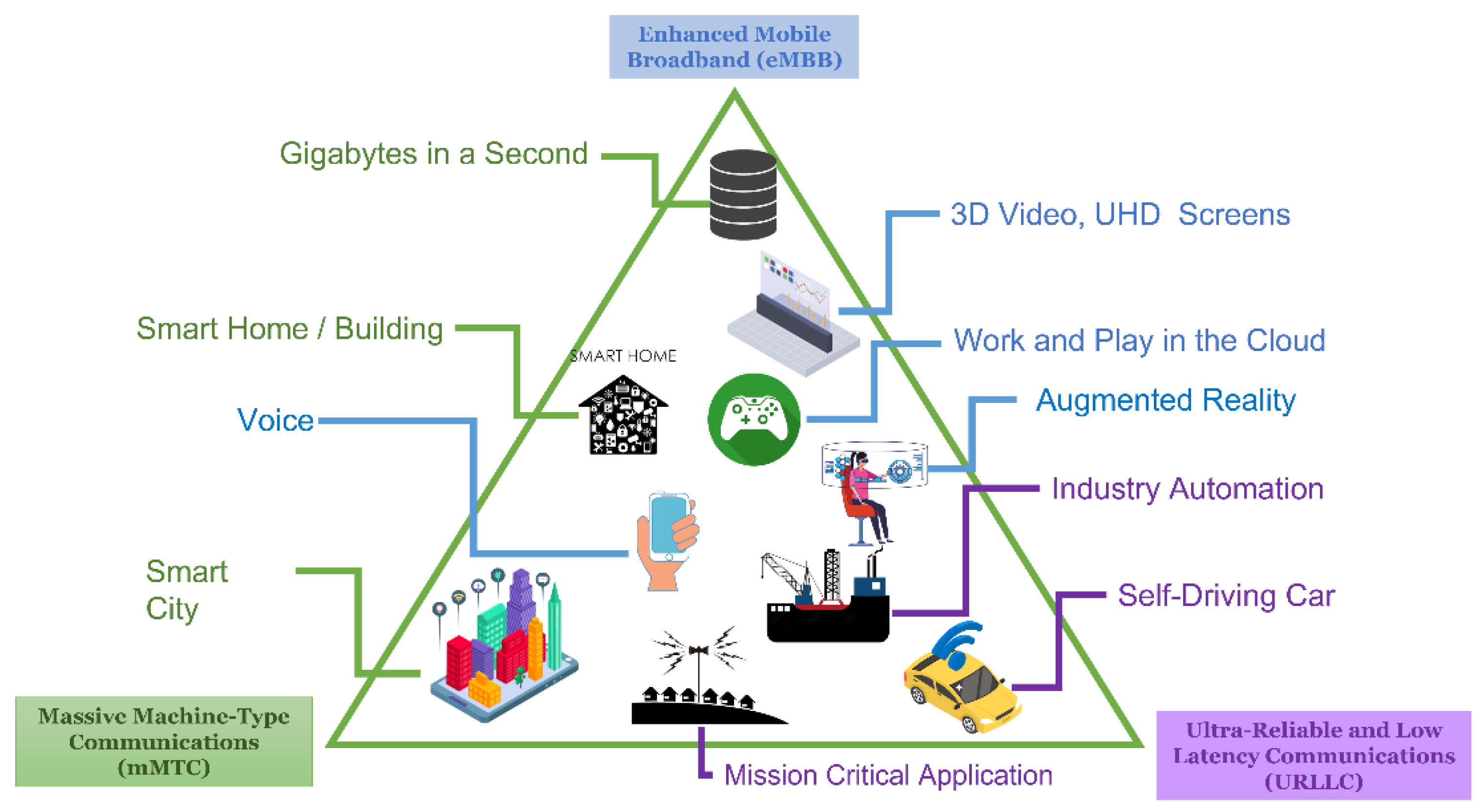
| Version | Summary | Created by | Modification | Content Size | Created at | Operation |
|---|---|---|---|---|---|---|
| 1 | Wilson de Jesus Arrubla Hoyos | -- | 2769 | 2022-10-25 16:20:49 | | | |
| 2 | Vivi Li | Meta information modification | 2769 | 2022-10-26 03:55:39 | | |
Video Upload Options
The growing global demand for food and the environmental impact caused by agriculture have made this activity increasingly dependent on electronics, information technology, and telecommunications technologies. In Colombia, agriculture is of great importance not only as a commercial activity, but also as a source of food and employment. However, the concept of smart agriculture has not been widely applied in this country, resulting in the high production of various types of crops due to the planting of large areas of land, rather than optimization of the processes involved in the activity. Due to its technical characteristics and the radio spectrum considered in its deployment, 5G can be seen as one of the technologies that could generate the greatest benefits for the Colombian agricultural sector, especially in the most remote rural areas, which currently lack mobile network coverage.
1. Introduction
2. Agriculture 4.0

3. Smart Farming (SF)
4. 5G Usage Scenarios
5. 5G Frequency Bands and Their Applications
| Band range | Typical Spectrum Types | 5G App1 | 5G App2 |
|---|---|---|---|
| <1 GHz | 600 MHz, 700 MHz, 800 MHz, 900 MHz |
Rural/unlicensed | Urban, WLAN(IoT) |
| 1–6 GHz | 1800 MHz 3.3–3.8 GHz |
Urban/unlicensed | IoT/ITS |
| >6 GHz | (6–28 GHz)—24 GHz, 26 GHz, 28 GHz |
UWB wireless fiber | Wireless VOD |
6. Projected 5G Frequency Bands in Colombia
| Band Range (MHz) | Total, Free Spectrum in Band (MHz) | Uplink (MHz) |
Downlink (MHz) |
Status | Operator | Reference |
|---|---|---|---|---|---|---|
| 600 | 70 | 663–698 | 617–652 | Available in March 2029 | - | [30] |
| 700 | 10 | 703–748 | 758–803 | Before September 2022 (auction). For 4G use, most of this frequency band was licensed in December 2019. |
Colombia Movil S.A (Tigo) (713–723 MHz couplet with 768–778 MHz) and (703–713 MHz couplet (758 MHz–768 MHz) Partners (Wom) 723–733 MHz couplet with (778–788 MHz. Comunicación Celular. S.A Comcel.SA (Claro) 733–743 MHz couplet with 788–798 MHz) |
[31][32][33][34][35][36][37][38][39][40][41][42][43][44][45] |
| 1900 | 5 | 1850–1910 | 1930–1990 | For 4G use, most of this frequency band was licensed in December 2019. | Established for IMT with no regulations in force for its use. | [32][33][34][35][36][37] |
| 2500 | 30 | 2500–2570 | 2620–2690 | Before September 2022 (auction). For 4G use, most of this frequency band was licensed in December 2019. |
Partners (Wom) 25154–(2520 MHz, couplet with 2635–2640 MHz) Comunicación Celular. S.A Comcel.SA (Claro) (2550–2555 MHz couplet with 2670–2675 MHz) (2545–2550 MHz 2665 couplet with 2670 MHz) (2540–2545 MHz 2660 couplet with 2665 MHz) |
[33][34][35][36][37][38][39][40][41][42][43][44][45] |
| 3500 | 400 | 3300–3700 (Canalization TDD) | Study auction | Unassigned operator | [30] | |
| 26,000 | 1000 | 24,250–27,500 | Available in 2027 | Unassigned operator | [27][45] | |

Relationship between IoT and 5G

7. Implementation of 5G Deployment in Colombia
| No. | Operator | Frequency Bands |
|---|---|---|
| 1 | Colombia Telecomunicaciones S.A E.S.P | 3500 MHz–3600 MHz |
| 2 | Comunicación Celular S.A Comcel S.A | 3500 MHz–3600 MHz |
| 3 | Empresa de Telecomunicaciones de Bógota S.A E.S.P | 3500 MHz–3600 MHz |
| 4 | ITICS S.A.S | 3500 MHz–3600 MHz |
| 5 | Xiris Investment Group SAS | 3300 MHz–3400 MHz |
Frequency Bands Identified in the 5G Deployment in Colombia
| Frequency bands | Advantages | Disadvantages | |
|---|---|---|---|
| Low band (frequencies below 1 GHz) |
600 MHz band (614–698 MHz) |
Lower propagation losses and, therefore, requires fewer base stations (BSs) to provide coverage | Lower available bandwidth compared to the rest of the bands |
| 700 MHz band (698–806 MHz) |
|||
| Medium bands (frequencies in the range of 1 to 6 GHz) |
3.4 GHz band (3.3–3.4 GHz) |
Spectrum harmonized with most countries in the world | High occupancy of the radio spectrum |
| 3.5 GHz band (3.4–3.6 GHz) |
|||
| 3.6 GHz band (3.6–3.7 GHz) |
|||
| High band (frequencies higher than 6 GHz) |
Item A (24.25–27.5 GHz) |
High amounts of radio spectrum are available for critical applications requiring low latency | High radio signal losses require a greater amount of BS to provide coverage |
| Banda de 28 GHz (26.5–29.5 GHz) |
|||
| Item B (31.8–33.4 GHz) |
|||
| Item C (37–40.5 GHz) |
|||
| Item K (71–76 GHz) |
|||
| Item L (81–86 GHz) |
|||
References
- Spedding, R.C. Ecología de los Sistemas Agrícolas; H. Blume Ediciones: Madrid, Spain, 1979.
- Ahmed, T.A.; El Gohary, F.; Tzanakakis, A.V.; Angelakis, N.A. Egyptian and Greek Water Cultures and Hydro-Technologies in Ancient Times. Sustainability 2020, 12, 9760.
- Dayioğlu, A.M.; Turker, U. Digital Transformation for Sustainable Future-Agriculture 4.0: A review. J. Agric. Sci. 2021, 27, 373–399.
- Said Mohamed, E.; Belal, A.A.; Kotb Abd-Elmabod, S.; El-Shirbeny, M.A.; Gad, A.; Zahran, B.M. Smart farming for improving agricultural management. Egypt. J. Remote Sens. Space Sci. 2021, 24, 971–981.
- Gebbers, R.; Adamchuk, I.V. Precision agriculture and food security. Science 2010, 327, 828–831.
- Mondal, P.; Basu, M. Adoption of precision agriculture technologies in India and in some developing countries: Scope, present status and strategies. Prog. Nat. Sci. 2009, 19, 659–666.
- Núñez, V.J.M.; Vargas, L.V.; Quezada, M.Y.L. Implementation of a participatory methodology based on STEAM for the transfer of ICT knowledge and creation of Agtech spaces for the co-design of solutions that contribute to the development of small and medium agricultural producers in Colombia, Panama and China. In Proceedings of the 2020 IEEE World Conference on Engineering Education (EDUNINE), Bogota, Colombia, 15–18 March 2020; pp. 1–6.
- Nyaga, J.M.; Onyango, C.M.; Wetterlind, J.; Söderström, M. Precision agriculture research in sub-Saharan Africa countries: A systematic map. Precis. Agric. 2021, 4, 22.
- Faid, A.; Sadik, M.; Sabir, E. An Agile AI and IoT-Augmented Smart Farming: A Cost-Effective Cognitive Weather Station. Agriculture 2022, 12, 35.
- Thorat, A.; Kumari, S.; Valakunde, D.N. An IoT based smart solution for leaf disease detection. In Proceedings of the 2017 International Conference on Big Data, IoT and Data Science (BID), Pune, India, 20–22 December 2017; pp. 193–198.
- Karim, F.; Karim, F. Monitoring system using web of things in precision agriculture. Procedia Comput. Sci. 2017, 110, 402–409.
- Navulur, S.; Prasad, G.M. Agricultural management through wireless sensors and internet of things. Int. J. Electr. Comput. Eng. 2017, 7, 3492.
- Alonso, S.R.; Sittón-Candanedo, I.; García, Ó.; Prieto, J.; Rodríguez-González, S. An intelligent Edge-IoT platform for monitoring livestock and crops in a dairy farming scenario. Ad Hoc Netw. 2020, 98, 102047.
- Islam, N.; Rashid, M.M.; Pasandideh, F.; Ray, B.; Moore, S.; Kadel, R. A Review of Applications and Communication Technologies for Internet of Things (IoT) and Unmanned Aerial Vehicle (UAV) Based Sustainable Smart Farming. Sustainability 2021, 13, 1821.
- Ramirez-Morales, I.; Mazon-Olivo, B.; Pan, A. Capítulo 1: Ciencia de datos en el sector agropecuario. In Análisis de Datos Agropecuarios; Universidad Técnica de Machala: Machala, Ecuador, 2018; pp. 12–44.
- Catelani, M.; Ciani, L.; Bartolini, A.; Del Rio, C.; Guidi, G.; Patrizi, G. Reliability Analysis of Wireless Sensor Network for Smart Farming Applications. Sensors 2021, 21, 7683.
- Naciones Unidas. Población|Naciones Unidas. Naciones Unidas. 2022. Available online: https://www.un.org/es/global-issues/population (accessed on 8 August 2022).
- Bacco, M.; Barsocchi, P.; Ferro, E.; Gotta, A.; Ruggeri, M. The Digitisation of Agriculture: A Survey of Research Activities on Smart Farming. Array 2019, 3–4, 100009.
- United Nations. “El Papel de la Gobernanza Electrónica en la Reducción de la Brecha Digital|Naciones Unidas,” United Nations. Available online: https://www.un.org/es/chronicle/article/el-papel-de-la-gobernanza-electronica-en-la-reduccion-de-la-brecha-digital (accessed on 8 August 2022).
- O’Shaughnessy, S.A.; Kim, M.; Lee, S.; Kim, Y.; Kim, H.; Shekailo, J. Towards smart farming solutions in the U.S. and South Korea: A comparison of the current status. Geogr. Sustain. 2021, 2, 312–327.
- World Bank. Water in Agriculture. Available online: https://www.bancomundial.org/es/topic/water-in-agriculture (accessed on 8 August 2022).
- Ghutke, P.; Agrawal, R. The utilization of IoT and remote sensor organizations and their application in agriculture for the improvement of yield productivity in India. In Proceedings of the 2021 2nd Global Conference for Advancement in Technology (GCAT), Bangalore, India, 1–3 October 2021; pp. 1–6.
- Balasubramaniyan, M.; Navaneethan, C. Applications of Internet of Things for smart farming—A survey. Mater. Today Proc. 2021, 47, 18–24.
- Tang, Y.; Dananjayan, S.; Hou, C.; Guo, Q.; Luo, S.; He, Y. A survey on the 5G network and its impact on agriculture: Challenges and opportunities. Comput. Electron. Agric. 2021, 180, 105895.
- Navarro-Ortiz, J.; Romero-Diaz, P.; Sendra, S.; Ameigeiras, P.; Ramos-Munoz, J.J.; Lopez-Soler, J.M. A Survey on 5G Usage Scenarios and Traffic Models. IEEE Commun. Surv. Tutor. 2020, 22, 905–929.
- UIT-R. Concepción de las IMT–Marco y objetivos generales del futuro desarrollo de las IMT para 2020 y en adelante; UIT-R: Geneva, Switzerland, 2015; p. 22.
- GSMA. 5G Spectrum, GSMA Public Policy Position. 2019. Available online: https://www.gsma.com/latinamerica/wp-content/uploads/2019/03/5G-Spectrum-Positions-InfoG.pdf (accessed on 8 August 2022).
- Constaín, S.; Gaviria, I.A.M. Plan 5G Colombia El Futuro Digital es de Todos; Ministerio de Tecnologías de la Información y las Comunicaciones: Bogotá, Colombia, 2019; p. 93.
- Mekuria, F.; Mfupe, L. Spectrum Sharing for Unlicensed 5G Networks. In Proceedings of the 2019 IEEE Wireless Communications and Networking Conference (WCNC), Marrakech, Morocco, 15–18 April 2019; pp. 1–5.
- ANE. Plan Maestro de Gestion de Espectro a 5 años. 2022. Available online: https://www.ane.gov.co/Sliders/archivos/Cargas%20Nuevas/Plan%20Maestro%20de%20Gestion%20de%20Espectro%20a%205%20a%C3%B1os.pdf (accessed on 8 August 2022).
- MinICT. Mintic Expects to Have a 5G Auction Before Government Ends-Mintic Expects to Have a 5G Auction Before Government Ends. MINTIC Colombia. Available online: http://www.mintic.gov.co/portal/715/w3-article-161584.html (accessed on 8 August 2022).
- MinICT. Spectrum Auction Remains: Sylvia Constain, ICT Minister-MINTIC Colombia. Available online: http://www.mintic.gov.co/portal/715/w3-article-118136.html (accessed on 8 August 2022).
- MinICT. Normogram of the Ministry of Information and Communications Technologies . Available online: https://normograma.mintic.gov.co/mintic/docs/resolucion_mintic_3078_2019.htm (accessed on 8 August 2022).
- MinICT. Normogram of the Ministry of Information and Communications Technologies . Available online: https://normograma.mintic.gov.co/mintic/docs/resolucion_mintic_3121_2019.htm (accessed on 8 August 2022).
- MinTIC. Resolution 1322-Preliminary Analysis of the Objective Selection Process for the Allocation of Spectrum Use Permits in IMT Bands. 2020. Available online: https://mintic.gov.co/portal/715/articles-146624_resolucion_1322_20200727.pdf (accessed on 8 August 2022).
- Qualcomm. Global Update on 5G Spectrum. 2019. Available online: https://www.qualcomm.com/content/dam/qcomm-martech/dm-assets/documents/spectrum-for-4g-and-5g.pdf (accessed on 8 August 2022).
- MinICT. Resolution 325-Granting a Permit for the Use of the Radio Spectrum to Comunicación Celular S.A. COMCEL S.A. con NIT 800.153.993—7. Available online: https://www.mintic.gov.co/micrositios/asignacion_espectro-imt/742/articles-172495_Resolucion_No__325.pdf (accessed on 8 August 2022).
- MinICT. Resolution 326-Granting a Permit for the Use of the Radio Spectrum to Comunicación Celular S.A. COMCEL S.A. con NIT 800.153.993—7. Available online: https://www.mintic.gov.co/micrositios/asignacion_espectro-imt/742/articles-172496_Resolucion_No__326.pdf (accessed on 8 August 2022).
- MinICT. Resolution 327-Granting a Permit for the Use of the Radio Spectrum to Comunicación Celular S.A. COMCEL S.A. S.A. con NIT 800.153.993—7. Available online: https://www.mintic.gov.co/micrositios/asignacion_espectro-imt/742/articles-172497_Resolucion_No__327.pdf (accessed on 8 August 2022).
- MinICT. Resolution 328-Granting a Permit for the Use of the Radio Spectrum to Comunicación PARTNERS TELECOM COLOMBIA S.A.S.354.361—1. Available online: https://www.mintic.gov.co/micrositios/asignacion_espectro-imt/742/articles-172499_Resolucion_No__328.pdf (accessed on 8 August 2022).
- MinICT. Resolution 330-Granting a Permit for the Use of the Radio Spectrum to PARTNERS TELECOM COLOMBIA S.A.S.354.361—1. Available online: https://www.mintic.gov.co/micrositios/asignacion_espectro-imt/742/articles-172501_recurso_1.pdf (accessed on 8 August 2022).
- MinICT. Resolution 331-Granting a Permit for the Use of the Radio Spectrum to a COMUNICACIÓN CELULAR S.A. COMCEL S.A. con NIT 800.153.993—7. Available online: https://www.mintic.gov.co/micrositios/asignacion_espectro-imt/742/articles-172502_recurso_1.pdf (accessed on 8 August 2022).
- MinICT. Resolution 332-Granting a Permit for the Use of the Radio Spectrum to co 8 COLOMBIA MÓVIL S.A. ESP con NIT 830.114.921—1. Available online: https://www.mintic.gov.co/micrositios/asignacion_espectro-imt/742/articles-172503_recurso_1.pdf (accessed on 8 August 2022).
- MinICT. Resolution 333-Granting a Permit for the Use of the Radio Spectrum to COLOMBIA MÓVIL S.A. ESP con NIT 830.114.921—1. Available online: https://www.mintic.gov.co/micrositios/asignacion_espectro-imt/742/articles-172504_recurso_1.pdf (accessed on 8 August 2022).
- ANE. Public Consultation on Available Bands for the Future Development of IMT in Colombia. 2020. Available online: https://www.ane.gov.co/Documentos%20compartidos/ArchivosDescargables/noticias/Consulta%20p%C3%BAblica%20sobre%20las%20bandas%20disponibles%20para%20el%20futuro%20desarrollo%20de%20las%20IMT%20en%20Colombia.pdf (accessed on 8 August 2022).
- MinICT. Documento Soporte y Consulta Pública. Desarrollo 5G en Colombia. Available online: https://www.mintic.gov.co/portal/715/articles-236811_documento_soporte_consulta_publica_desarrollo_5g_colombia.pdf (accessed on 8 August 2022).
- Khurpade, M.J.; Rao, D.; Sanghavi, P.D. A Survey on IOT and 5G Network. In Proceedings of the 2018 International Conference on Smart City and Emerging Technology (ICSCET), Mumbai, India, 5 January 2018; pp. 1–3.
- Painuly, S.; Sharma, S.; Matta, P. Future Trends and Challenges in Next Generation Smart Application of 5G-IoT. In Proceedings of the 2021 5th International Conference on Computing Methodologies and Communication (ICCMC), Erode, India, 8–10 April 2021; pp. 354–357.
- Chettri, L.; Bera, R. A Comprehensive Survey on Internet of Things (IoT) Toward 5G Wireless Systems. IEEE Internet of Things J. 2020, 7, 8879484.
- MinICT. Ministry of Information and Communications Technology-Adoption of 5G technology in Colombia. 2020. Available online: https://mintic.gov.co/micrositios/plan_5g//764/articles-162230_recurso_1.pdf (accessed on 8 August 2022).
- MinICT. Informe de Asignación–Espectro Para Uso de Pruebas Tecnicas 5G; Ministerio de las tecnologías de la Información y las Comunicaciones MINTIC: Bogotá, Colombia, 2020. Available online: http://www.mintic.gov.co/portal/715/w3-article-180029.html (accessed on 8 August 2022).
- MinICT. Resolution 467 of 1 July 2020; Ministry of Information and Communications Technology-MinICT: Bogotá, Colombia, 2020. Available online: https://normograma.mintic.gov.co/mintic/docs/resolucion_icanh_0467_2020.htm (accessed on 8 August 2022).
- MinICT. Resolution 000638 of 1 April 2020; Ministry of Information and Communications Technology - MinICT: Bogotá, Colombia, 2020; pp. 1–6. Available online: https://micrositios.mintic.gov.co/plan_5g/pdf/resolucion_638.pdf (accessed on 8 August 2022).
- MinICT. Resolución Numero-00722 DE 30 de Abril de 2020. 2020. Available online: https://www.mintic.gov.co/portal/604/articles-135751_resolucion.pdf (accessed on 8 August 2022).
- MinICT. ‘El 5G Será Una Herramienta de Sofisticación Para el Desarrollo Industrial Colombiano’: Walid David, Viceministro de Conectividad del MinTIC. MINTIC Colombia. Available online: http://www.mintic.gov.co/portal/715/w3-article-180029.html (accessed on 8 August 2022).





